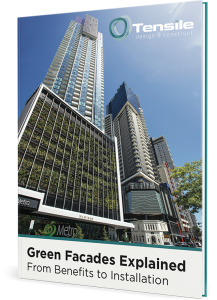Green facades can provide multiple benefits for a building and its surrounding environment – from cooling and shading to pollution reduction and improved aesthetics.
Some of these benefits are measurable. Here are some of the differences a green facade can make.
Climate and weather
Some studies show a reduction of six degrees in the surrounding air temperature on average for a wall with a green facade compared to one without. In addition, researchers at the University of Cardiff measured green surfaces from several cities, and found that the hotter the climate, the greater this cooling effect.
Several mechanisms are involved in this:
- The shading effect of plants reduces the level of direct solar radiation on the wall surface. The radiation from the sun is instead absorbed into the foliage for photosynthesis, which reduces heat build-up on the wall surface and reflection of heat into the surrounding air.
- An insulating layer and cooling breeze can be created where there is a gap between the foliage and the wall surface.
- Watering and hydroponic methods can improve the cooling effect through evaporation.
- Evergreen plants can help to protect a building from heavy rain and keep it drier.
- Deciduous plants, which shed in the winter, can allow in more heat from the sun in the cooler seasons, warming the building at the right time of year.
Air quality and pollution
Facade greenery can reduce pollution and improve air quality in the nearby vicinity, through the capture of particulate matter. Once captured, the pollutants are washed away through watering and rainfall.
Different plants vary in their capacity to do this, and it also depends on the leaf surface area of the foliage. Planting a variety of species may help improve the capture of pollutants.
Insulating effect
The air gap formed between a facade structure and the wall face can improve insulation between 10 and 33%. This in turn can reduce cooling costs in the summer and heating in the winter.
Studies show a 5cm air gap is sufficient for this effect, and that there is no significant improvement with a wider gap.
Health and biodiversity
Facades can be designed to attract species that help improve biodiversity. Examples include rare or native birds, bees for pollination, and beetles that feed on garden pests.
Research indicates that greater biodiversity and green spaces in urban environments can both contribute to improvements in human health.
If you would like to know more facts about green facades, or you have a project in mind, get in touch with our team.





































